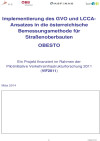OBESTO – Implementation of the user oriented and Life Cycle Costing approach in the Austrian design method for upper road structures
Short Description
Starting point / motivation
Based on the pavement design method actually applied the Austrian standard RVS 03.08.63 (2008) defines standard pavements for different load classes and HMA construction types. These constructions were determined on the basis of an analytical design method using a so called model asphalt with a defined stiffness and fatigue behaviour, which is not able to describe the characteristics of modern HMA mixtures accurately.
The traffic load is considered through a standard axle using equivalent damage factors relating the damage induced by the standard axle and the damage induced by heavy vehicles. This approach isn't capable to describe realistic traffic loads. In addition, only the bearing capacity (technical life span) of the respective pavement is taken into account. An evaluation of the economic feasibility is not provided.
Contents and goals
In the course of this project, this design was adapted. Instead of the model asphalt, the behaviour of the bituminous mixture actually used was considered. Three possible ways were employed to do this:
- a database for standard asphalts was planned, in which material properties (stiffness values and fatigue parameters) are collected;
- with the help of a multiscale model for asphalt, asphalt stiffness could be estimated from the elastic properties of bitumen and the volumetric composition of the respective bituminous mixture; and
- relevant material properties could be collected from stiffness and fatigue tests, respectively.
Methods
For each of these options, a standardized procedure was developed. Actual traffic counting data and consideration of essential vehicle types out of significant heavy traffic collectives, as well as statistical distributions of gross weight and axial loads are used to describe existing traffic loads. Together with climatic conditions, the material characteristics, as well as the traffic load were input parameters of the design process.
Using linear layered analysis and maximum shear stress theory according to Leon a one-dimensional strain state could be determined. This strain state was used within a fatigue criterion, considering different fatigue parameters depending on the asphalt used.
With the resulting partial damage rates for different vehicle types and temperature periods, an overall damage rate, as well as a technical life span could be ascertained.
In addition to the technical evaluation the economic feasibility of the respective pavement type was evaluated within the design process by introducing a standardized life-cycle cost analysis in order to calculate its annual costs and annuity.
Results and Conclusions
The design method presented herein will be the basis of a complete revision of the Austrian standard RVS 03.08.63. It should give awarding authorities within the public procurement process, designers of road pavements and the asphalt paving companies the opportunity to develop and evaluate innovative pavement types and to stipulate the use of reclaimed asphalt in the mix design process. HMA materials are in the focus to foster sustainable, long lasting pavements and innovative specific of this improve design method.
Publications
OBESTO – Implementation of the user oriented and Life Cycle Costing approach in the Austrian design method for upper road structures

Within this project, performance-based material behaviour of Hot Mix Asphalt (HMA) was implemented in the Austrian design approach. Considering actual asphalt mechanic behaviour, as well as specific traffic loads and climatic conditions, the structural technical life time of road pavements with different bitumen, bitumen systems and mix design could be determined and considered in the design process. In addition, a standardized life-cycle cost analysis helped to evaluate and identify the economic differences between alternative pavement types. The results of this project should be the basis for a complete revision of the Austrian pavement design standard, RVS 03.08.63.
Univ.-Prof. DI Dr Ronald Blab, DI Lukas Eberhardsteiner, DI Katrin Haselbauer, DI Bettina Marchart, DI Torsten Hessmann
Publisher: BMVIT
German, 147 Seiten
Publication Downloads
Project Partners
Project management
Univ. Prof. Dipl.-Ing. Dr Ronald Blab, Technische Universität Wien - Institut für Verkehrswissenschaften
Project partners
- DI Dr. Karl Kappl, ALPINE Bau GmbH
- Univ.-Prof.Dr. Michael P. Wistuba, Technische Universität Braunschweig, Deutschland - Institut für Straßenwesen
- Dr. Michael Kostjak, Swietelsky BaugesmbH
- Dr. Peter Kremnitzer, Teerag Asdag
- Dr. Markus Spiegl, OMV Refining&Marketing GmbH
Contact Address
Vienna University of Technology - Institute of Traffic Sciences
Univ. Prof. Dipl.-Ing. Dr Ronald Blab
Tel.: +43 (1) 58801-23314
E-mail: ronald.blab@tuwien.ac.at
